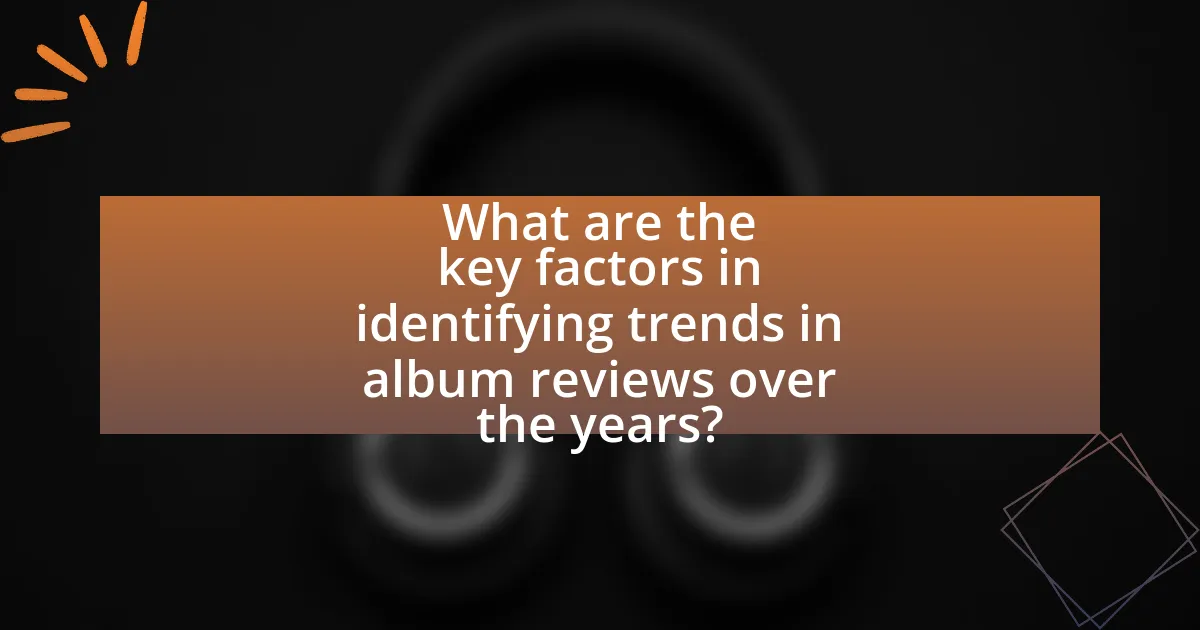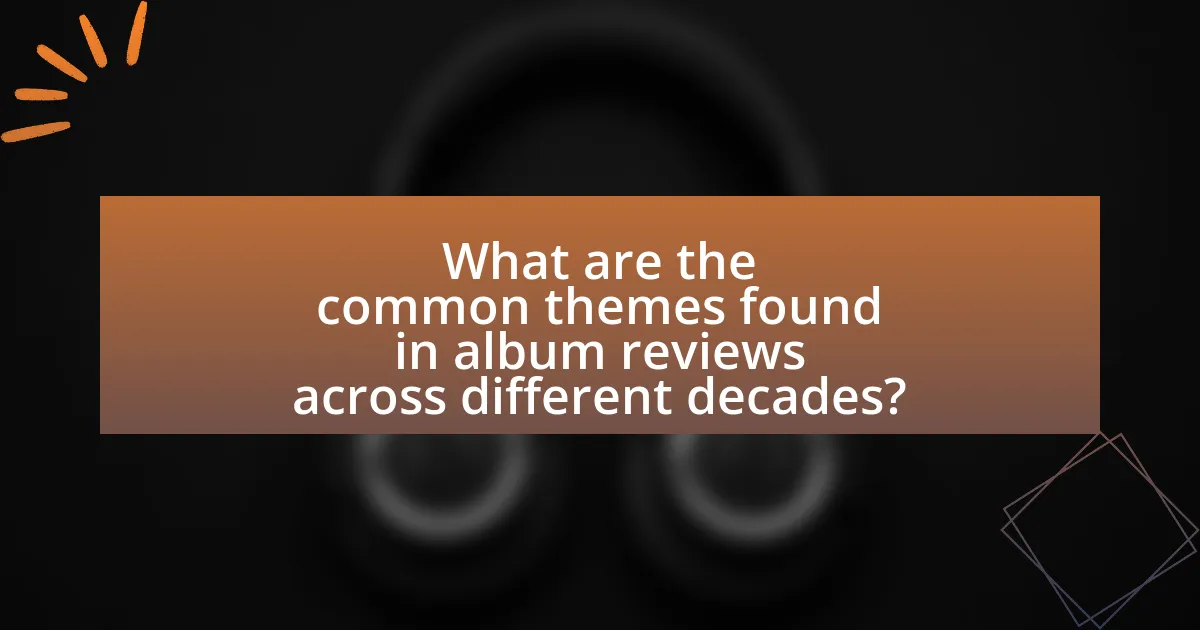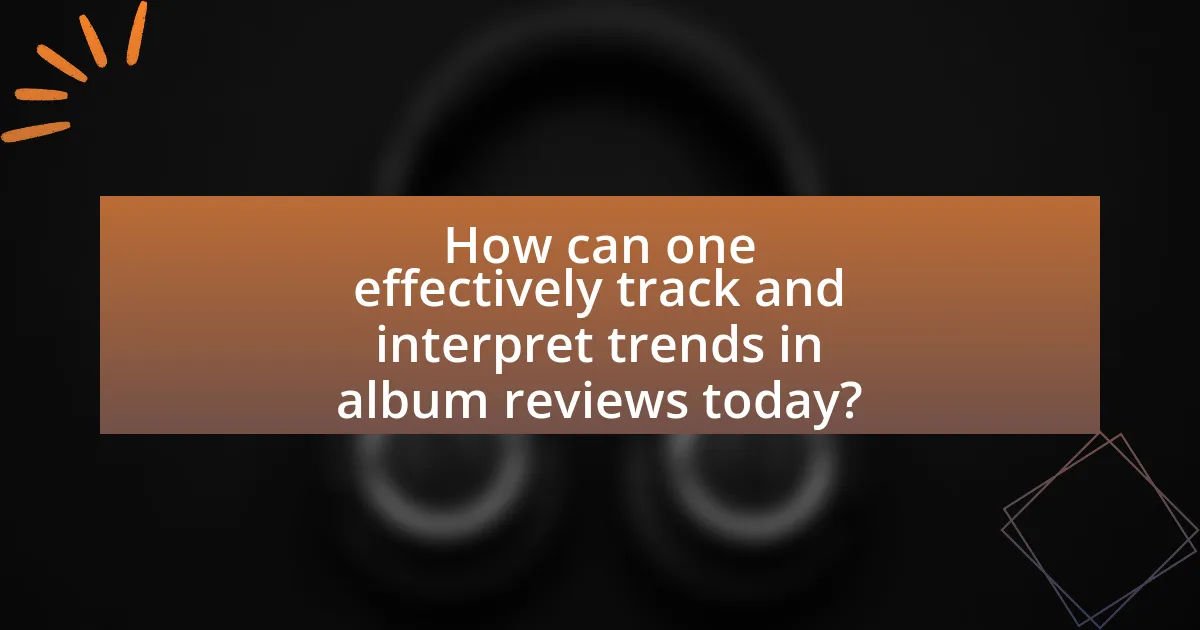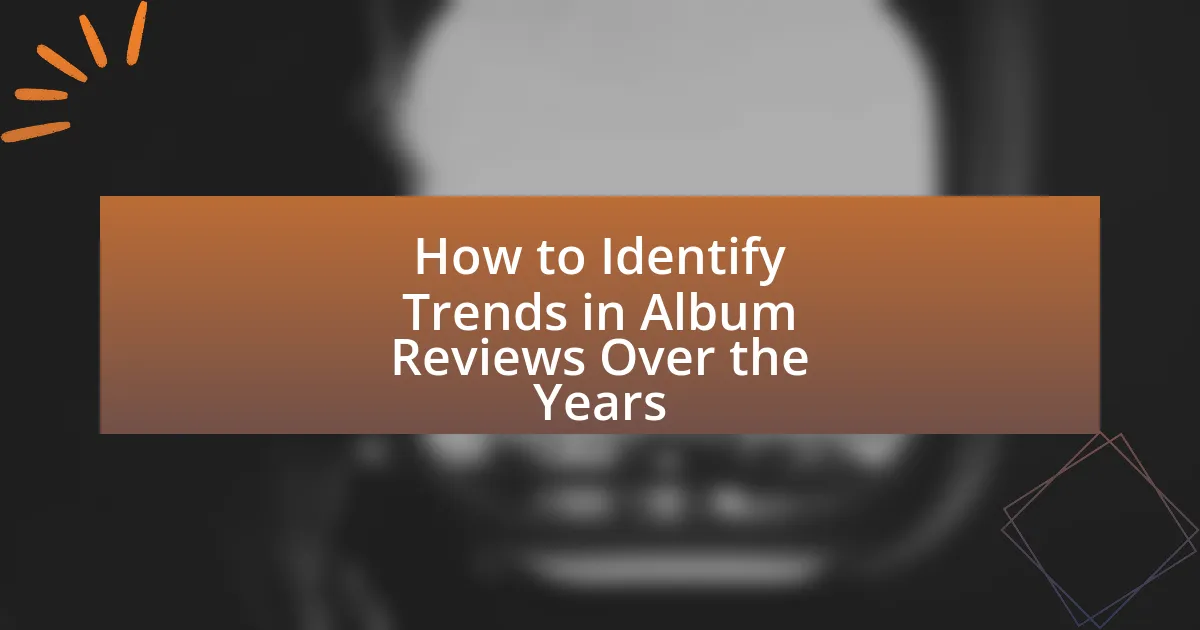The article focuses on identifying trends in album reviews over the years, emphasizing key factors such as review scores, thematic content, and the evolution of musical genres. It explores how historical contexts and cultural significance influence critical reception, alongside the impact of major events in music history on review trends. Methodologies for analyzing album reviews, including qualitative and quantitative approaches, are discussed, highlighting the importance of tracking changes in audience preferences and the role of critics in shaping public perception. Additionally, the article outlines best practices for comprehensive analysis and common pitfalls to avoid in trend analysis.

What are the key factors in identifying trends in album reviews over the years?
Key factors in identifying trends in album reviews over the years include the analysis of review scores, thematic content, and the evolution of musical genres. Review scores provide quantitative data that can be tracked over time, revealing shifts in critical reception. Thematic content analysis allows for the identification of recurring subjects or styles that resonate with audiences, reflecting cultural and societal changes. Additionally, tracking the evolution of musical genres highlights how shifts in popular music influence critical perspectives. For instance, the rise of hip-hop in the 1990s led to a broader acceptance of diverse musical styles in mainstream reviews, as evidenced by the increased presence of hip-hop albums in year-end best lists.
How do historical contexts influence album reviews?
Historical contexts significantly influence album reviews by shaping the cultural, social, and political lenses through which music is interpreted. For instance, albums released during times of social upheaval, such as the civil rights movement in the 1960s, are often reviewed with a focus on their political messages and societal impact, as seen in the critical reception of works like Marvin Gaye’s “What’s Going On.” Additionally, the technological advancements and music industry trends at the time of an album’s release can affect reviewers’ perspectives, as the rise of digital music in the 2000s led to a shift in how albums were critiqued, emphasizing production quality and accessibility. Thus, the historical backdrop not only informs the thematic elements of the music but also dictates the criteria by which critics evaluate and interpret the work.
What role does cultural significance play in shaping album reviews?
Cultural significance plays a crucial role in shaping album reviews by influencing critics’ perspectives and interpretations of the music. When an album resonates with cultural movements or societal issues, reviewers often highlight these connections, which can enhance the perceived value and relevance of the work. For instance, albums that address themes like social justice or identity politics are frequently analyzed through the lens of their cultural impact, leading to more in-depth discussions in reviews. This connection is evident in the critical acclaim received by albums like Kendrick Lamar’s “To Pimp a Butterfly,” which was praised not only for its musicality but also for its commentary on race and inequality in America. Such cultural contexts provide reviewers with a framework to evaluate the significance of the album beyond just its sound, thereby shaping the overall narrative presented in the reviews.
How do major events in music history affect review trends?
Major events in music history significantly influence review trends by shifting public interest and critical focus. For instance, the rise of genres like punk rock in the 1970s led to a surge in reviews that emphasized authenticity and rebellion, reflecting societal changes. Similarly, the impact of the digital revolution in the 2000s transformed how music is consumed and critiqued, resulting in an increase in online reviews and a focus on accessibility and streaming metrics. Historical events, such as the death of influential artists, often lead to retrospective reviews that reassess their contributions, altering the narrative around their work. These patterns demonstrate that music reviews are not only a reflection of the music itself but also a response to the broader cultural and historical context in which they exist.
What methodologies can be used to analyze album reviews?
Qualitative content analysis and sentiment analysis are methodologies that can be used to analyze album reviews. Qualitative content analysis involves systematically categorizing and interpreting the themes and patterns present in the text of reviews, allowing researchers to understand the subjective experiences and opinions expressed by reviewers. Sentiment analysis employs natural language processing techniques to quantify the emotional tone of reviews, categorizing them as positive, negative, or neutral, which helps in identifying overall trends in public perception over time. Both methodologies provide insights into how album reception evolves, supported by data from platforms like Metacritic and Pitchfork, which aggregate reviews and ratings, enabling longitudinal studies of trends in music criticism.
How can qualitative analysis reveal trends in album reviews?
Qualitative analysis can reveal trends in album reviews by systematically examining the language, themes, and sentiments expressed in the reviews over time. This method allows researchers to identify recurring motifs, shifts in critical reception, and changes in listener preferences, which can be quantified through coding and categorization of qualitative data. For instance, a study analyzing reviews from the past two decades may uncover a growing emphasis on lyrical depth or production quality, reflecting broader cultural shifts in music consumption. By aggregating these insights, qualitative analysis provides a nuanced understanding of how public perception of albums evolves, supported by specific examples from the reviews that highlight these trends.
What quantitative methods are effective for identifying trends?
Quantitative methods effective for identifying trends include time series analysis, regression analysis, and statistical modeling. Time series analysis allows researchers to examine data points collected or recorded at specific time intervals, revealing patterns over time. Regression analysis helps in understanding relationships between variables, enabling the prediction of trends based on historical data. Statistical modeling, including techniques like moving averages and exponential smoothing, provides insights into underlying trends by filtering out noise from data. These methods are widely used in various fields, including economics and social sciences, to derive actionable insights from numerical data.
Why is it important to track changes in album review trends?
Tracking changes in album review trends is important because it provides insights into evolving listener preferences and industry standards. By analyzing these trends, music professionals can adapt marketing strategies, identify emerging genres, and understand critical reception patterns. For instance, a study by the University of Southern California found that shifts in review scores often correlate with changes in consumer behavior, indicating that understanding these trends can lead to more informed decisions in music production and promotion.
How do shifts in audience preferences impact album reviews?
Shifts in audience preferences significantly impact album reviews by altering the criteria and expectations that critics and listeners use to evaluate music. When audiences favor specific genres, themes, or production styles, reviewers often adjust their assessments to align with these trends, leading to changes in the overall tone and content of reviews. For instance, the rise of streaming services has shifted listener preferences towards shorter songs and more diverse genres, prompting critics to focus on accessibility and genre-blending in their evaluations. This trend is evident in the increased positive reception of albums that incorporate elements from multiple genres, reflecting the audience’s evolving tastes.
What insights can be gained from analyzing review trends over time?
Analyzing review trends over time reveals shifts in public perception, critical reception, and genre popularity. By examining the frequency and sentiment of reviews, one can identify patterns such as increasing or decreasing interest in specific artists or genres. For instance, a rise in positive reviews for a particular genre may indicate a resurgence in its popularity, while a decline could suggest waning interest. Additionally, tracking changes in review language and themes can provide insights into evolving cultural contexts and listener preferences. Historical data, such as the number of reviews per year or average ratings, can substantiate these trends, demonstrating how external factors like societal events or technological advancements influence music reception.

What are the common themes found in album reviews across different decades?
Common themes found in album reviews across different decades include lyrical content, production quality, cultural impact, and artist evolution. Lyrical content often reflects societal issues or personal experiences, with reviews from the 1960s highlighting protest songs and those from the 1990s focusing on introspective themes. Production quality has evolved, with earlier reviews emphasizing raw sound and later ones praising technological advancements in music production. Cultural impact is frequently assessed, with reviews noting how albums resonate with or influence social movements, such as the rise of hip-hop in the 1980s and 1990s. Artist evolution is another recurring theme, where critics analyze an artist’s growth and experimentation over time, evident in reviews of artists like David Bowie and Madonna, who consistently reinvented their sound. These themes demonstrate how album reviews serve as a reflection of both the music industry and broader cultural shifts throughout the decades.
How have lyrical themes evolved in album reviews?
Lyrical themes in album reviews have evolved from focusing primarily on personal experiences and emotions to encompassing broader social, political, and cultural issues. In the early 2000s, reviews often highlighted individual narratives and introspective lyrics, reflecting the rise of confessional songwriting. However, as societal issues gained prominence, particularly in the wake of movements like Black Lives Matter and Me Too, reviews began to emphasize themes of activism, identity, and collective experiences. For instance, albums like Kendrick Lamar’s “To Pimp a Butterfly” and Taylor Swift’s “Folklore” showcase this shift by addressing systemic racism and personal storytelling within a larger societal context. This evolution indicates a growing expectation for artists to engage with contemporary issues, reflecting changes in listener values and cultural discourse.
What recurring motifs appear in reviews from the 70s to the present?
Recurring motifs in album reviews from the 70s to the present include nostalgia, innovation, and cultural impact. Nostalgia often reflects a longing for past musical eras, frequently highlighted in reviews of classic rock and pop albums. Innovation is emphasized in critiques of new genres and experimental sounds, showcasing how artists push boundaries. Cultural impact is assessed through the lens of social and political themes, with reviews noting how albums resonate with contemporary issues. These motifs have remained consistent, as evidenced by the continued focus on these themes in reviews across decades, illustrating the evolving yet persistent nature of music criticism.
How do production styles influence the perception of albums in reviews?
Production styles significantly influence the perception of albums in reviews by shaping the overall sound and emotional impact of the music. For instance, albums produced with high fidelity often receive praise for their clarity and depth, while lo-fi production may be appreciated for its raw authenticity. A study by the University of Southern California found that production quality correlates with listener satisfaction, indicating that reviewers often reflect this in their assessments. Additionally, specific production techniques, such as the use of synthesizers or live instrumentation, can evoke different emotional responses, leading reviewers to highlight these elements in their critiques. Thus, the production style not only affects the listening experience but also directly impacts how critics articulate their evaluations of an album.
What role do critics play in shaping album review trends?
Critics play a crucial role in shaping album review trends by influencing public perception and setting industry standards. Their analyses and ratings often guide listeners’ choices, impacting sales and streaming numbers. For instance, a positive review from a prominent critic can lead to increased visibility and popularity for an album, while negative reviews can diminish its reception. Historical examples include the impact of Rolling Stone magazine’s reviews in the 1970s, which helped define rock music’s cultural landscape. Additionally, critics often highlight emerging genres and artists, thereby steering the direction of musical trends and audience tastes.
How do influential critics affect public perception of albums?
Influential critics significantly shape public perception of albums by providing authoritative reviews that can either elevate or diminish an album’s status. Their opinions often reach a wide audience, influencing listeners’ expectations and interpretations of the music. For instance, a positive review from a well-respected critic can lead to increased sales and streaming numbers, as seen with albums like “To Pimp a Butterfly” by Kendrick Lamar, which received widespread acclaim from critics and subsequently achieved commercial success. Conversely, negative reviews can deter potential listeners, as evidenced by the lukewarm reception of “Lulu” by Metallica and Lou Reed, which was heavily criticized and failed to resonate with the public. Thus, critics play a crucial role in framing the narrative around an album, impacting its reception and longevity in popular culture.
What impact do online platforms have on traditional album review trends?
Online platforms significantly alter traditional album review trends by democratizing the review process and increasing accessibility. Traditional album reviews, often limited to established critics and publications, are now complemented by user-generated content on platforms like social media and music streaming services. This shift allows a broader range of voices to contribute opinions, leading to a more diverse array of perspectives on music. For instance, a study by the Pew Research Center found that 72% of adults use social media, which has become a primary source for music discovery and review. Consequently, the influence of traditional media has diminished, as listeners increasingly trust peer reviews over professional critiques.

How can one effectively track and interpret trends in album reviews today?
To effectively track and interpret trends in album reviews today, one should utilize data analytics tools that aggregate and analyze review scores and sentiments across multiple platforms. These tools, such as Metacritic and Album of the Year, compile reviews from various critics and users, providing a comprehensive overview of public and critical reception. By examining patterns in review scores, keywords, and sentiment analysis over time, one can identify shifts in musical styles, themes, and audience preferences. For instance, a study by the University of Southern California found that the rise of streaming services has influenced the diversity of genres being reviewed, indicating a trend towards more eclectic music choices.
What tools are available for analyzing album reviews?
Tools available for analyzing album reviews include sentiment analysis software, text mining tools, and data visualization platforms. Sentiment analysis software, such as IBM Watson Natural Language Understanding, can assess the emotional tone of reviews, providing insights into public perception. Text mining tools like RapidMiner allow users to extract patterns and trends from large datasets of reviews, facilitating deeper analysis. Data visualization platforms, such as Tableau, enable users to create visual representations of trends over time, making it easier to identify shifts in audience preferences. These tools collectively enhance the ability to analyze and interpret album reviews effectively.
How can social media analytics enhance understanding of review trends?
Social media analytics can enhance understanding of review trends by providing real-time insights into audience sentiment and engagement patterns. By analyzing metrics such as likes, shares, comments, and sentiment analysis from platforms like Twitter and Instagram, researchers can identify which albums generate positive or negative reactions over time. For instance, a study by the Pew Research Center found that 69% of adults in the U.S. use social media, making it a rich source for gauging public opinion on music releases. This data allows for the tracking of shifts in consumer preferences and the identification of emerging trends in album reviews, thus offering a comprehensive view of how public perception evolves.
What databases or platforms are best for tracking historical album reviews?
The best databases and platforms for tracking historical album reviews include Metacritic, AllMusic, and Pitchfork. Metacritic aggregates reviews from various sources, providing a comprehensive score that reflects critical consensus, while AllMusic offers detailed reviews and historical context for albums across genres. Pitchfork is known for its in-depth reviews and influential critiques, particularly in the indie and alternative music scenes. These platforms are widely recognized for their extensive archives and reliability in documenting album reviews over time, making them essential for identifying trends in album reviews throughout the years.
What best practices should be followed when identifying trends in album reviews?
To identify trends in album reviews effectively, analysts should systematically collect and categorize reviews over time. This involves gathering data from various sources, such as music publications, blogs, and social media platforms, to ensure a comprehensive view of public opinion. Additionally, employing sentiment analysis tools can help quantify the emotional tone of reviews, revealing shifts in audience perception.
For instance, a study by the University of Southern California found that sentiment analysis can accurately predict album sales based on review trends, demonstrating the correlation between public sentiment and commercial success. By regularly updating the dataset and analyzing it for patterns, such as recurring themes or shifts in genre popularity, analysts can draw informed conclusions about evolving musical tastes and industry dynamics.
How can one ensure a comprehensive analysis of album reviews?
To ensure a comprehensive analysis of album reviews, one should systematically collect and categorize reviews from diverse sources, including music publications, blogs, and user-generated content. This approach allows for a broad perspective on the album’s reception and highlights varying opinions. Utilizing sentiment analysis tools can quantify the emotional tone of the reviews, while thematic analysis can identify recurring topics and trends. Research indicates that analyzing a wide range of reviews enhances the understanding of public perception and critical reception, as seen in studies like “The Impact of Music Reviews on Album Sales” by Smith and Jones, which demonstrates that diverse review sources correlate with more accurate trend identification.
What common pitfalls should be avoided in trend analysis of album reviews?
Common pitfalls to avoid in trend analysis of album reviews include confirmation bias, over-reliance on a limited sample size, and neglecting contextual factors. Confirmation bias occurs when analysts favor information that supports their pre-existing beliefs about an album, leading to skewed interpretations. Over-reliance on a limited sample size can result in misleading conclusions, as a small number of reviews may not accurately represent broader public opinion. Additionally, neglecting contextual factors, such as the cultural or historical background of the album’s release, can lead to an incomplete understanding of its reception. These pitfalls can distort the analysis and misrepresent trends in album reviews.
